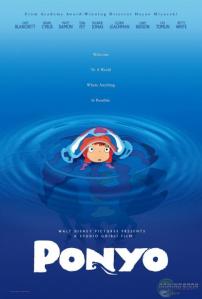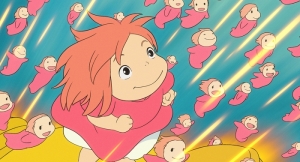**SPOILER ALERT**
Gake no ue no Ponyo is a 2008 movie written and directed by Hayao Miyazaki, with the English version featuring voices of such famous stars as Cate Blanchett, Matt Damon, Tina Fey, Liam Neeson, Cloris Leachman, and Betty White.
“The plot centers on a fish-girl who lives in an aquarium in her father’s underwater castle with numerous smaller sisters. When her father takes her and her siblings on an outing in his four-flippered submarine, Ponyo is driven by a desire to see even more of the world and floats away on the back of a jellyfish. She ends up stranded on the shore of a small fishing town and is rescued by a boy named Sosuke, who cuts his finger in the process. She licks his wound when he picks her up, and the wound heals almost instantly. After taking a great liking to her, Sosuke names her Ponyo and promises to protect her forever. Meanwhile, her father, Fujimoto, is looking for his daughter. Upset that she ran away, he believes the humans have now kidnapped her, and he calls his wave spirits to return Ponyo to him. After the wave spirits take Ponyo away, Sosuke is heartbroken and goes home with his mother, Lisa, who tries to cheer him up to no avail.
Ponyo and her father have a confrontation, during which Ponyo refuses to let her father call her by her birthname, “Brunhilde.” She declares her name to be Ponyo and voices her desire to become human, because she has started to fall in love with Sosuke. Suddenly she starts to grow legs and turn into a human, a consequence of the human blood she swallowed when she licked Sosuke’s finger. Her father turns her back with difficulty and goes to summon Ponyo’s mother. Meanwhile, Ponyo, with the help of her sisters, breaks away from her father and releases his magic to make herself human. The huge amount of magic released into the ocean causes an imbalance in the world, resulting in a huge tsunami. Riding on the waves of the storm, Ponyo goes back to visit Sosuke. Lisa, Sosuke, and Ponyo wait out the storm at Sosuke’s house, and the next morning Lisa leaves to check up on the residents of the nursing home where she works.
Granmamare, Ponyo’s mother, arrives at Fujimoto’s submarine. On her way there, Sosuke’s father has seen and recognized her as the Goddess of Mercy. Fujimoto notices the moon has come out of its orbit and satellites are falling like shooting stars. Granmamare declares that if Sosuke can pass a test, Ponyo can live as a human and the world order will be restored. If he fails, Ponyo will turn into sea foam. Sosuke and Ponyo wake up to find that most of the land around the house has been covered by the ocean. Lisa has not come home yet, so with the help of Ponyo’s magiv, they make Sosuke’s toy boat life-size and set out to find Lisa.
While traveling, they see prehistoric fish swimming beneath them. After landing and finding Lisa’s empty car, Ponyo and Sosuke go through a tunnel. There Ponyo loses her human form and reverts into a fish. Sosuke and Ponyo are taken by Fujimoto into the ocean and down to the protected nursing home where they are reunited with Lisa and meet Granmamare, both of whom have just had a long private conversation. Granmamare asks Sosuke if he can love Ponyo whether she is a fish or human. Sosuke replies that he “loves all the Ponyos.” Granmamare then allows Ponyo to become human once Sosuke kisses her on the surface. The film ends with Ponyo jumping up and kissing Sosuke, transforming into a little girl in mid-air.”
This movie is based partially on the original version of The Little Mermaid, but with a happier ending.













![488_tmb[1]](https://malonewc.wordpress.com/wp-content/uploads/2011/02/488_tmb1.jpg?w=640)

![nausic06[1]](https://malonewc.wordpress.com/wp-content/uploads/2011/02/nausic061.jpg?w=640)

![animefact-anime[1]](https://malonewc.wordpress.com/wp-content/uploads/2011/02/animefact-anime1.jpg?w=640)
![Hayao_Miyazaki[1]](https://malonewc.wordpress.com/wp-content/uploads/2011/02/hayao_miyazaki1.jpg?w=213&h=300)





